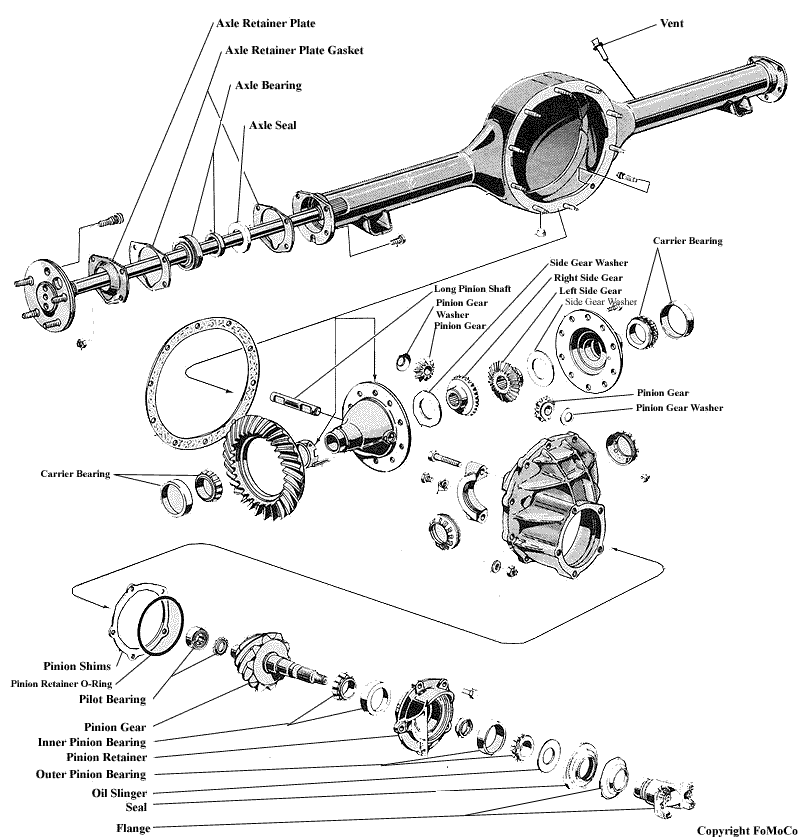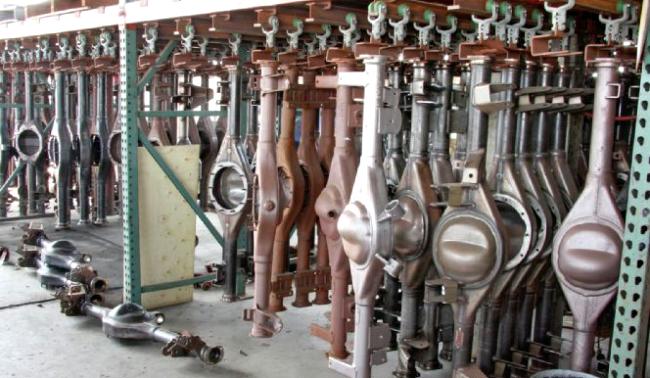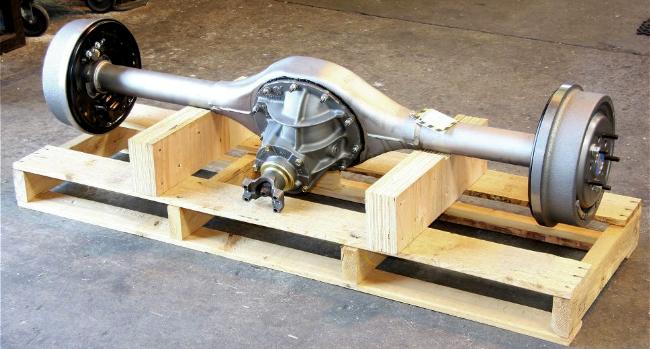Ford used the axle from around the 1957 model year right up until the early 1980’s in cars and trucks. It was not the only axle used, but was by far one of the best.
Variations by Ford exist in the size of the outer axle bearings in the housings and carriers both, as well as with the spline count on the axle shafts. Generally most cars received the small axle bearings and 28-spline axle shafts. Exceptions to this were the ultra Hi performance Boss 302’s, Boss 429’s, 427’s, 428 CJ/SCJ and the 429 cars which received the 31-spline carriers and axle shafts. These used what is referred to as a N-case. Some of the heavier cars like the Galaxies also received the larger wheel bearing housings.
“N CASE”
The case of course most desirable is the N case, first used on the 427 Galaxies around 64-65 I believe.They are most often found behind the later 428CJ and 429CJ cars.From what I have seen don’t expect to find them in 390 or 289 Hipo cars.The N cases went with 31 spline centers and are for rugged duty.And believe it or not, they were also used in some FE equipped Ford 1/2 ton 4X4 pickups!
The trucks varied more, early half ton trucks got the 28-spline axles and carriers, while sometime in the early 70’s the switch was made to mostly 31-spline axles and carriers for most trucks. Most of the later trucks also received the larger axle bearings housings. One exception to this was the Bronco’s from 1966 to 1977, they stayed with the 28-spline units. A small bearing housing can be differentiated from a large bearing housing by the size of the nuts and thread used to retain the brake backing plates to the housing, the small bearing housings use 9/16″ socket size nuts with 3/8″ fine thread, while the larger bearing use 11/16″ socket size and 7/16″ fine thread. Gross Vehicle Weight ( GVW ) would determine which axle housing many cars and trucks received.
Because many half ton trucks continued to utilize the 9-inch (both 2 wheel & 4 wheel drives) right up until about 1982, these housings are by far the most abundant. Since the “Limited slip” or Locking rear end (often referred to as a “POSI”) came to be a popular option and more plentiful starting in the early 1970’s, many of the units found today at car swap meets and shows are the units pulled from trucks with the 31-spline carriers and “Traction Loc” style posi unit. The actual car posi units, which were primarily 28-spline carriers, can be much more difficult to locate. This is because the supply is limited to the few cars and early Broncos (and some early trucks) which received them. When it comes down to actual shafts as well, since the truck lug pattern in most cases differed from the car, and due to the bearing size differences, 28-spline car axle shafts are much more abundant than the 31-spline car shafts. Generally, aftermarket shafts have to be purchased if one wants to use a 31-spline truck carrier in a car.
The most common carrier housing found is the C7AW-E. It is the one most commonly found in the trucks up to around 1982. It’s uncertain if this “E” version of the case came into use in 1967 or in subsequent years, but it is by far the most abundant case being used in both full size Ford cars and trucks throughout the 1970’s. It has been said that it has a higher nickel content and better casting than the earlier single ribbed cases it replaced, and that is why it remained in use for so long.
The “N Case” was no longer needed for passenger car/truck applications due to the demise of most performance engine options in the 70’s.
Axle housings also evolved over the years:
The earlier housings used in cars from 1957 to mid 1960’s tended to be the weakest and had abrupt ending but welded carrier centers to tubes and a smooth backside.
Later housings appeared in either 1966 or 1967 with the familiar “Hump” in the backside middle and stronger tubes.
The later truck housings received even beefier center carrier housings and tubes, and this style of center carrier housing is best suited for drag cars or narrowed rear ends due to the added strength in the middle.
Most of the early housings are ok for the average street performance cars. The popular early swap being the 1957-1959 Ford for the 1965/1966 Mustang.
Mustangs and Fairlane axle housings are often grouped together because they are the same width, but the distance between spring perches is different between Mustangs and Fairlanes. Spring perches must be cut and re-welded in order for the swap to be performed.
The “rough” widths I keep in mind for Mustangs are the following:
52-inch for 1965-1966 (the same width as 1964-1965 Falcons and 1962-1965 Fairlanes – as in the Mustang line, most however never received a factory 9-inch).
54-inch for 1967-1970 (same as 1966-1969 Fairlane, Torino, Comet & Cyclone non station wagons-cars with 351 and up engines received 9-inch units – as did some 302 4V cars with optional gear ratios).
56-inch for the 1971-1973 Mustangs – cars with 351 engines and up receiving the 9-inch housings.
Keep in mind as mentioned, the Fairlane spring perch distances were not the same as the Mustang. All the Galaxies I have seen from throughout the 1960’s used the 9-inch rear, regardless of engine size.
Axle Widths:
- 1965-1966 Mustang 57.25 inches
- 1967-1970 Mustang 59.25 inches
- 1971-1973 Mustang 61.25 inches
- 1977-1981 Versailles 58.50 inches
- 1967-1973 Mustang, Torino, Ranchero, Fairlane 9-inch 59.25 inches to 61.25 inches
- 1957-1959 Ranchero and station wagon rears, 57.25 inches
- 1966-1977 Bronco 9-inch, 58 inches
- 1977-1981 Granada/Versailles, 58 inches
- 1967-1971 Comet, Cougar, Mustang, Fairlane, 59.25 inches
- 1971-1973 Mustang, 61.25 inches
- 1964 Falcon 58 inches
- 1967 Cougar 60 inches
- 1967 Fairlane 63.50 inches (coil springs)
- 1972 Ford Van 3/4 ton 68 inches
- 1973-1986 65.25 inches
- 1957-1959 Ranchero and station wagon 57.25 inches (narrowest 9-inch housing)
- 1966-1977 Bronco 58 inches but has 5-on-5 1/2 inch diameter bolt circle
- 1967-1973 Torinos, Rancheros, Fairlanes 59.25 inches or 61.25 inches
- 1967-1971 Comets, Cougars, Fairlanes 59.25 inches
- 1974-1986 F-150 65 inches
- 1978-1986 Ford Bronco 65 inches
Where To Find:
- 1967-1973 medium and big block Mustangs and Cougars
- 1966-1971 Fairlanes, Torinos, Montegos, Comets, and other Ford intermediates with big blocks
- 1957-1959 V8 Fords and Mercurys
- 1977-1981 Lincoln Versailles & Trucks
Ford F-150 9-Inch Axles:
The Ford 9-inch can be found under 1974-1986 F-150s and 1978-1986 Broncos. It features the legendary Ford 9-inch ring and pinion strength, 5-on-5.5 lug pattern (same as older Jeep), a 65-inch width at the wheel mounting surfaces, large-bearing semi-floating axles, and many can be found with hefty 31-spline axleshafts. Another bonus is that the axleshafts are of equal length, so you’ll only need to carry one spare should you choose to.
Type Of 9-Inch Housings:
- 1967-1973 Mustang/Cougar – light duty, thinnest housing material, small axle bearings, 28 and 31 splines
- 57-68 passenger car and 1/2 ton truck – medium duty, stronger than Mustang type, 28 and 31 splines
- Ranchero/Torino – heavy duty thick wall housing, 3.25 inch diameter axle tubes with flat tops
- 1969-1977 Galaxies (coils), Lincolns (coils), and late pickups (leaf)- 3.25 inch diameter all the way to the backing plate, coil housings have upper control arm mount
How To Recognize 9-Inch Housing Centers:
- 1957 – no dimples, flat center band up the center of the rear cover, bottom drain plug
- 1958-1959 – two dimples on back of housing, flat center band, some had drain holes
- 1960-1967 – two dimples, flat center band, oil level hole in back cover
- 1963-1977 Lincoln, LTD, Thunderbirds had 9.375 inch centers, housings were cut away at the gasket surface for ring gear clearance, one curved rib at the front top portion of differential, strong but no gears
Types of 9″ Axles:
- 28-spline axles cannot be shortened and resplined (they’re tapered)
- 1972 and earlier 31-spline axles have the ability to be shortened
- 1973 and later 9-inch (cars) have a 5-on-5 bolt circle and the axles cannot be shortened
- 1967-1973 Mustang axles identified by wheel flange:
- oval hole – 28-splines
- two large holes and counter sunk center – 31 splines
More Facts:
- 5 on 5 lug pattern is a truck pattern
- A 9-inch complete rear axle is approximately 35 pounds heavier than an 8.8 rear axle with approximately the same components.
- It is common to find a 9-inch in a old Falcon or Comet that has had a HIPO SMALL block with 31-splines and a locker.
- If the case has two verticle RIBS ,from top to middle of case it is a good IRON type IF in the very center of this case there is the letter “N” than this is a NODULAR CASE (GREAT) this is the strongest factory case made BY FORD!!!
- The ranger truck works good with a 9-inch from a 1964-1971 Falcon, Comet, some 1965-1969 Mustangs or 1964-1967 Ranchero V8 cars.
You can easily tell this is a 9-inch from the hump in the rear and (2) dimples. Also note there isn’t a cover on the rear like most axles.
You can tell this is a 9-inch from the removable carrier on the front.

Resources:
http://kevinstang.com/Ninecase.htm




